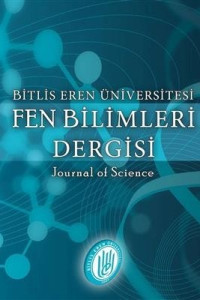Öz
Porous materials are at the forefront of research in terms of providing superior insulation properties and energy efficiency. The most important point that makes porous materials different and unique is the space inside the pore. Aerogel has become the insulation material that stands out as the most interesting alternative in this context. In this study, the production of aerogel insulation materials with high insulation properties, suitable mechanical properties and different contents was aimed. Silica aerogels are synthesized using the sol-gel technique with Hydrolysis, Condensation, Aging, Solvent change and Surface modification, Drying main steps in general. According to the results obtained, it was determined that the densities of the aerogels produced were in the range of 0.66 to 1.053 g/ml and the thermal conductivity values were in the range of 0.067 to 0.097 W/mK. The results show that many opportunities are available to improve the insulation property of aerogel, which is considered an important insulation material of the future.
Anahtar Kelimeler
Proje Numarası
BTUBAP-2018-MMF-6
Kaynakça
- [1] A. Enes, “Silika Aerojel Sentezinde Farklı Katalizör Kullanımının Etkisi ve Adsorpsiyon Kapasitesinin Belirlenmesi,” Gazi Üniversitesi, Ankara, 2019.
- [2] R. Baetens, B. P. Jelle, and A. Gustavsen, “Aerogel insulation for building applications: A state-of-the-art review,” Energy Build., vol. 43, no. 4, pp. 761–769, 2011.
- [3] N. K. Mermer, “Silika Temelli Aerojellerin Sol-Jel Yöntemi ile Sentezi ve Yapısal Özelliklerin İncelenmesi,” Yıldız Teknik Üniversitesi, Istanbul, 2018.
- [4] N. Saraç, “Silika esaslı doğal hammadde ve atıklardan aerojel tozu üretimi ve karakterizasyonu,” Sakarya Üniversitesi, Sakarya, 2018.
- [5] T. Li and T. Wang, “Preparation of silica aerogel from rice hull ash by drying at atmospheric pressure,” Mater. Chem. Phys., vol. 112, no. 2, pp. 398–401, 2008.
- [6] Y. Yilmaz, “Farklı başlangıç maddeleri kullanılarak sol-jel yöntemiyle monolitik silika aerojel ve silika aerojel sentezi ve karakterizasyonu,” Gazi Üniversitesi, Ankara, 2013.
- [7] Z. Li, X. Cheng, L. Gong, Q. Liu, and S. Li, “Enhanced flame retardancy of hydrophobic silica aerogels by using sodium silicate as precursor and phosphoric acid as catalyst,” J. Non Cryst. Solids, vol. 481, pp. 267–275, 2018.
- [8] S. M. Jones, “Aerogel: Space exploration applications,” J. Solgel Sci. Technol., vol. 40, no. 2–3, pp. 351–357, 2006.
- [9] N. Siyin, “Yüksek Sıcaklık Isı Yalıtım Uygulamalarına Yönelik Üstün Performanslı Aerojel Şilte Sentezi ve Karakterizasyonu,” İstanbul Teknik Üniversitesi, İSTANBUL, 2016.
- [10] S.-W. Hwang and S.-H. Hyun, “Capacitance control of carbon aerogel electrodes,” J. Non Cryst. Solids, vol. 347, no. 1–3, pp. 238–245, 2004.
Öz
Destekleyen Kurum
Batman Üniversitesi
Proje Numarası
BTUBAP-2018-MMF-6
Kaynakça
- [1] A. Enes, “Silika Aerojel Sentezinde Farklı Katalizör Kullanımının Etkisi ve Adsorpsiyon Kapasitesinin Belirlenmesi,” Gazi Üniversitesi, Ankara, 2019.
- [2] R. Baetens, B. P. Jelle, and A. Gustavsen, “Aerogel insulation for building applications: A state-of-the-art review,” Energy Build., vol. 43, no. 4, pp. 761–769, 2011.
- [3] N. K. Mermer, “Silika Temelli Aerojellerin Sol-Jel Yöntemi ile Sentezi ve Yapısal Özelliklerin İncelenmesi,” Yıldız Teknik Üniversitesi, Istanbul, 2018.
- [4] N. Saraç, “Silika esaslı doğal hammadde ve atıklardan aerojel tozu üretimi ve karakterizasyonu,” Sakarya Üniversitesi, Sakarya, 2018.
- [5] T. Li and T. Wang, “Preparation of silica aerogel from rice hull ash by drying at atmospheric pressure,” Mater. Chem. Phys., vol. 112, no. 2, pp. 398–401, 2008.
- [6] Y. Yilmaz, “Farklı başlangıç maddeleri kullanılarak sol-jel yöntemiyle monolitik silika aerojel ve silika aerojel sentezi ve karakterizasyonu,” Gazi Üniversitesi, Ankara, 2013.
- [7] Z. Li, X. Cheng, L. Gong, Q. Liu, and S. Li, “Enhanced flame retardancy of hydrophobic silica aerogels by using sodium silicate as precursor and phosphoric acid as catalyst,” J. Non Cryst. Solids, vol. 481, pp. 267–275, 2018.
- [8] S. M. Jones, “Aerogel: Space exploration applications,” J. Solgel Sci. Technol., vol. 40, no. 2–3, pp. 351–357, 2006.
- [9] N. Siyin, “Yüksek Sıcaklık Isı Yalıtım Uygulamalarına Yönelik Üstün Performanslı Aerojel Şilte Sentezi ve Karakterizasyonu,” İstanbul Teknik Üniversitesi, İSTANBUL, 2016.
- [10] S.-W. Hwang and S.-H. Hyun, “Capacitance control of carbon aerogel electrodes,” J. Non Cryst. Solids, vol. 347, no. 1–3, pp. 238–245, 2004.
Ayrıntılar
| Birincil Dil | İngilizce |
|---|---|
| Konular | Makine Mühendisliği (Diğer) |
| Bölüm | Araştırma Makalesi |
| Yazarlar | |
| Proje Numarası | BTUBAP-2018-MMF-6 |
| Erken Görünüm Tarihi | 25 Aralık 2023 |
| Yayımlanma Tarihi | 28 Aralık 2023 |
| Gönderilme Tarihi | 22 Ağustos 2023 |
| Kabul Tarihi | 15 Aralık 2023 |
| Yayımlandığı Sayı | Yıl 2023 Cilt: 12 Sayı: 4 |


